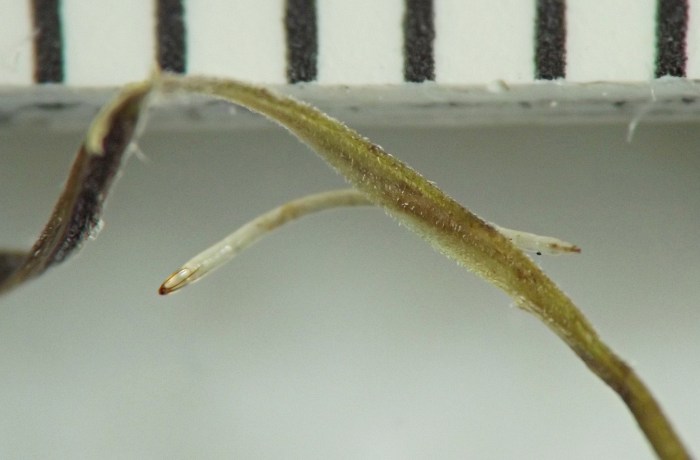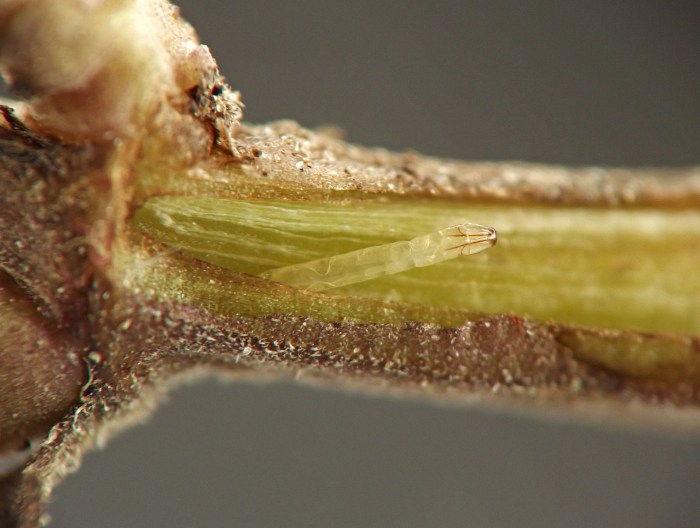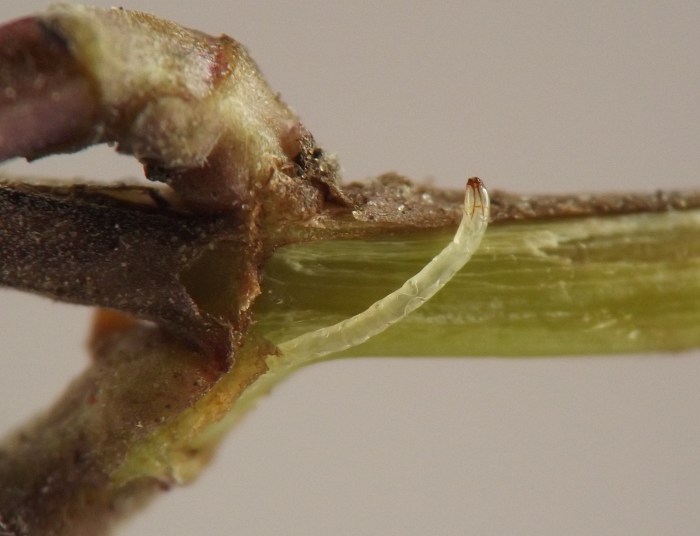Miner/borer (Lepidoptera: Opostegidae) in stems, leaves, etc. of Monarda [0339]
| Order | Lepidoptera |
|---|---|
| Family | Opostegidae[T,L] |
| Lower taxon | cf. Pseudopostega |
| No. spp. involved | One confirmed |
| Feeding mode | Leaf blade, midrib, and petiole miner; stem miner; miner/borer in aerial stems, ground-level horizontal rooting stems and apparently in rhizomes |
| Host plant | Bee balm / wild bergamot, Monarda fistulosa (Lamiaceae) |
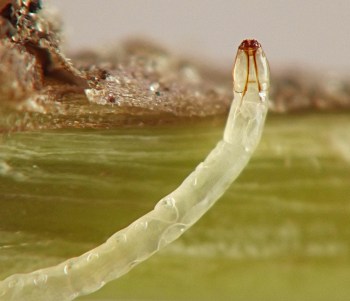
During its first growing season, the larva of this opostegid is most readily detected by the long, narrow linear mines it creates in leaves of its hostplant. But the larva is not restricted to mining leaves. In addition to feeding in the leaf blade, it will enter the leaf midrib and petiole, as well as the main (aerial) stem and lateral shoots. From there, the larva may proceed into the ground-level horizontal rooting stems or the belowground rhizomes -- covering a distance of several decimeters as it migrates through the body of the plant. The feeding in aerial stems takes the form of shallow, externally visible linear mines with a more-or-less-central frass line. At least initially, these mines do not appear thick enough to have been created by mature larvae, and they often seem to lead all the way down the stem to the ground, disappearing into plant tissues at or below ground level, which suggests that the larvae forming these mines do not finish feeding in the aerial stems. However, in the current study, the lower portion of one aerial stem was found with damage that appeared consistent with what might be expected from a mature opostegid larva completing its feeding here at the end of its first growing season, perhaps then exiting the stem and overwintering as a pupa in a cocoon; nevertheless, the stem damage could not be confirmed as the work of an opostegid, so this finding is inconclusive.
At least some larvae feed within ground-level or belowground parts of the hostplant, to which they presumaby migrate after completing initial feeding in leaves and aerial stems. Dissection of a ground-level horizontal rooting stem in late August revealed tunneling accomplished at an undetermined time by a larva that was no longer present. In early May 2023, a middle-instar larva was found in another ground-level horizontal rooting stem. This stem consisted of still-living plant tissue that had been produced during the previous growing season, and the larva had overwintered inside it or adjacent tissue, judging from the lack of significant aboveground growth of the host, the cool temperatures of the early springtime when the larva was found, and the fact that the larva was sluggish and nearly immobile as if still undergoing diapause. The following year, in late May, mature larvae were found in the lower stems of new shoots of the hostplant. The extent of the tunneling in the new shoots was somewhat limited and confined to a relatively short length of lower stem; the tunnels appeared fairly wide, as if created only by later-instar larvae; and in one plant a blackened tunnel clearly led from the belowground parts into the affected area of the new shoot. This evidence, combined with the relative freshness of the aboveground hostplant tissue, and the fact that larvae reached maturity so early in the season, together strongly suggests that the larvae had migrated into the spring growth from their overwintering location in the ground-level or belowground tissues of the plant. The larvae's feeding in the spring shoots caused the lower stems to discolor and swell slightly. One larva was found inside the terminus of its tunnel in the stem, with its head positioned just below the semicircular exit slit it had just cut in the stem epidermis. After being removed from the stem for photography, this larva promptly spun a rusty-colored, somewhat dorsoventrally flattened ovoid cocoon.
Given the known flight periods of several North American species of Pseudopostega, it seems likely that most of these Monarda-feeding larvae that mature and pupate in spring emerge as adults a few weeks later. Pseudopostega cretea and P. quadristrigella adults have both been collected starting in mid-June in Illinois (Microleps.org 2023), and the flight period for P. albogaleriella is reported as "primarily during June and July into early August over the northern part of [its] range" (Davis and Stonis 2007, p. 73). Whichever species is responsible, a significant number of individuals must emerge as adults in time to give rise to a new generation of larvae by sometime in July, because the long linear leaf mines seem to first appear around this time (Eiseman 2022, p. 1733), and at least some of these leaf mines are most likely caused by recently hatched larvae based on their very narrow width and the way they seem to originate in the leaf blade (as if from eggs laid there).
Update, summer 2024 - spring 2025: In September 2024, the middle to upper portion of an aerial stem of the hostplant was found to contain a semicircular exit slit in the middle of a shallowly tunneled area similar in form to a blotch leaf mine. The mined area was approximately 12cm in length, and showed discoloration and buckling of the epidermis similar to the damage described above in spring shoots. Peeling back the epidermis revealed at least two parallel rows of frass in one portion of the mine. The exit slit appeared fairly fresh, suggesting the larva had emerged within the previous month. The tunnel and exit slit characteristics were similar to confirmed opostegid damage in spring shoots as described above, but could not be conclusively identified as such. (See images 0339-60 through 0339-62 and 0339-66, below.) Furthermore, in an interesting case of cohabitation, during late May 2025 a wilted shoot of the host was located that contained a recently evacuated opostegid tunnel in the lowermost portion of the stem and, just above this, a tunnel occupied by a Papaipema larva (Lepidoptera: Noctuidae). There was a short region of undisturbed stem (less than 10mm in length) between the areas affected by the opostegid and the noctuid, with no overlap between the areas. (See images 0339-67 through 0339-71, below.)










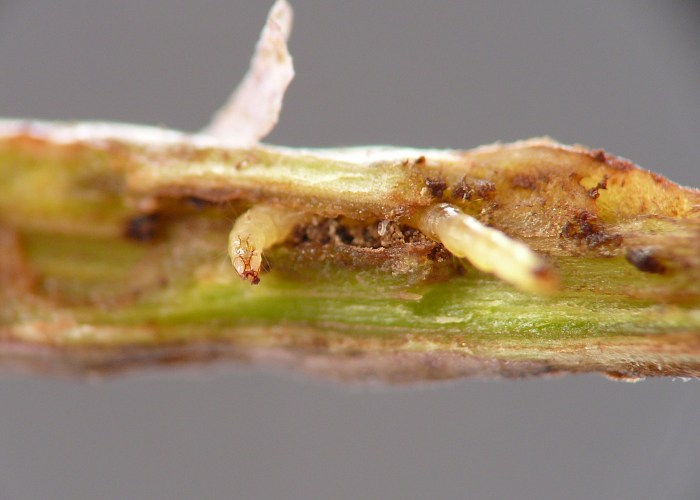






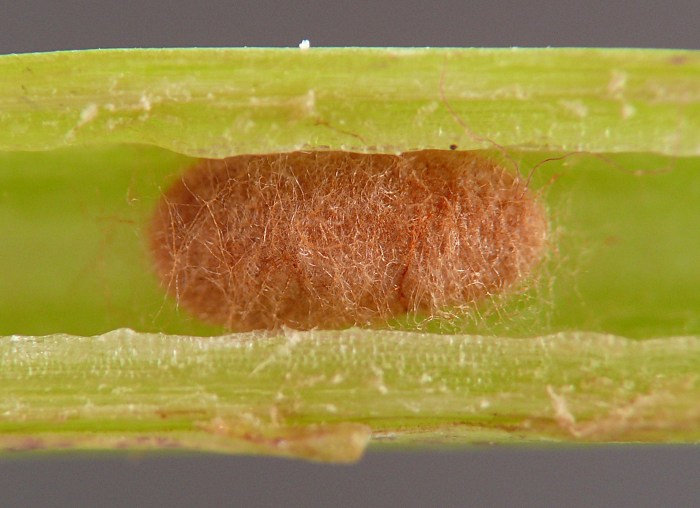










Specimen data for images
Coll. 08/01/23, photographed on 08/01/23-08/02/23 (01-18) and 08/23/23 (19); coll. 05/01/23, photographed on 05/01/23-05/02/23 (20-36), larva transplanted into spring growth on 05/02/23 and spring growth with larva photographed on 05/03/23 (37) and 05/07/23 (38); coll. 05/22/24, field photos same day (39-40), lab photos same day (41-56), cocoon spun by 05/26/24 and photographed on 05/26/24 (57-58); dead stem photographed in the field on 03/23/24 (59); coll. 05/27/25, field and lab photos same day (67-71); coll. 09/11/24, lab photos same day (60-62, 66).
All specimens above from the Upper Midwest, USA.
References
Davis, D.R. and J.R. Stonis. 2007. A revision of the New World plant-mining moths of the family Opostegidae (Lepidoptera: Nepticuloidea). Smithsonian Contributions to Zoology no. 625, 212 pp., 503 figs., 19 maps, 2 tables.
Eiseman, C.S. 2022. Leafminers of North America, 2nd edition. Self-published e-book. Available from the author at https://charleyeiseman.com/leafminers/.
Harrison, T. 2023. Family Opostegidae. On Microleps.org [website]. Retrieved November 5, 2023 from http://www.microleps.org/Guide/Opostegidae/index.html.
Page created 11/05/23. Last update: 06/02/25














